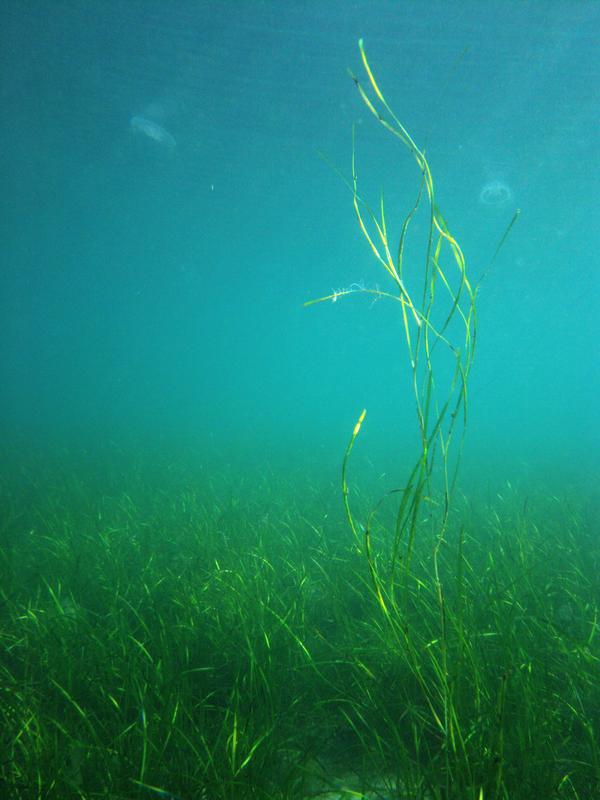Land Plant Became Key Marine Species

Eelgrass Frithjof Moy
Eelgrass belongs to a group of flowering plants that have adapted to a life in water. As such, it is a suitable candidate for studies of adaptation and evolution.
‘Since flowering plants have emerged and developed on land, eelgrass can be expected to share many genetic features with many land plants. Studying differences between them can tell us how eelgrass has adapted to a marine environment,’ says Mats Töpel, researcher at the Department of Marine Sciences, University of Gothenburg, who participated in the sequencing of the eelgrass genome.
Töpel is part of an international research collaboration involving 35 research teams. As a result of their efforts, the eelgrass genome has now been published in Nature.
A life on land no longer possible
One interesting discovery made by the scientists is that eelgrass has lost not only the special cells that flowering plants need to be able to ‘breathe’ (meaning to absorb carbon dioxide and release oxygen) but also the genes required to form these cells.
‘This is a good example of how evolution extends beyond mere accumulation of useful traits; organisms can also benefit from losing certain genes and characteristics,’ says Töpel.
Eelgrass – a key species in trouble
Eelgrass belongs to a group of plants generally referred to as seagrass and forms gigantic submarine meadows along European, North American and Asian shores. The plant has adapted to many different environments, from the bitter Arctic cold to the warm waters further south.
In all of these environments, eelgrass serves an important function in the ecosystem by binding sediments and acting as a nursery for young fish and other animals. It also influences our own environment by binding large amounts of nutrients and carbon dioxide.
‘Lately, the eelgrass meadows have disappeared in many places, and a lot of research is underway to figure out how these ecosystems work and what we can do to protect them,’ says Töpel.
Further studies remain
The genome of an organism contains huge amounts of information.
‘So far we have only scratched the surface. A vast number of bioinformatic analyses of eelgrass remain to be done. And the increasing availability of genomes of other organisms enables us to make new comparisons,’ says Töpel.
Link to article: http://www.nature.com/nature/journal/vaop/ncurrent/full/nature16548.html
The research on the eelgrass genome has been led by Professor Jeanine Olsen from the University of Groningen. During parts of the work, Professor Olsen has served as visiting professor at the University of Gothenburg and has then been affiliated with the Linnaeus Centre for Marine Evolutionary Biology (CeMEB, http://cemeb.science.gu.se/).
Contact information:
Mats Töpel, researcher at CeMEB, Department of Marine Sciences, University of Gothenburg
mats.topel@marine.gu.se , mobile: +46 (0)70 406 5292, office: +46 (0)31 786 3738
http://www.gu.se/english/about_the_university/news-calendar/News_detail//land-pl…
Media Contact
All latest news from the category: Life Sciences and Chemistry
Articles and reports from the Life Sciences and chemistry area deal with applied and basic research into modern biology, chemistry and human medicine.
Valuable information can be found on a range of life sciences fields including bacteriology, biochemistry, bionics, bioinformatics, biophysics, biotechnology, genetics, geobotany, human biology, marine biology, microbiology, molecular biology, cellular biology, zoology, bioinorganic chemistry, microchemistry and environmental chemistry.
Newest articles

High-energy-density aqueous battery based on halogen multi-electron transfer
Traditional non-aqueous lithium-ion batteries have a high energy density, but their safety is compromised due to the flammable organic electrolytes they utilize. Aqueous batteries use water as the solvent for…

First-ever combined heart pump and pig kidney transplant
…gives new hope to patient with terminal illness. Surgeons at NYU Langone Health performed the first-ever combined mechanical heart pump and gene-edited pig kidney transplant surgery in a 54-year-old woman…

Biophysics: Testing how well biomarkers work
LMU researchers have developed a method to determine how reliably target proteins can be labeled using super-resolution fluorescence microscopy. Modern microscopy techniques make it possible to examine the inner workings…





















